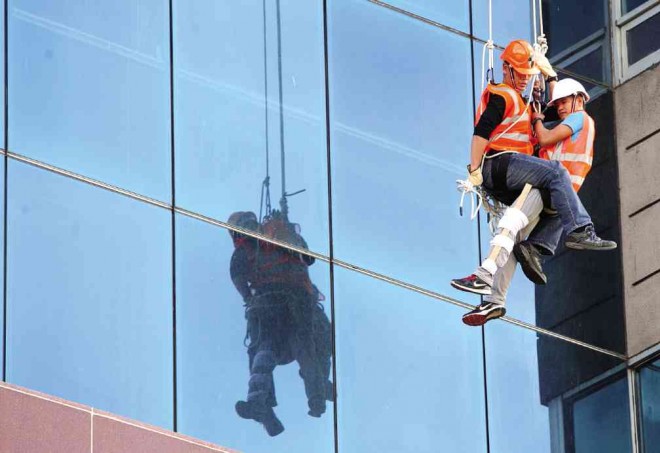
A SAFETY worker lowers a “victim” during a simulation quake drill at Cebu Business Park in Cebu City. TONEE DESPOJO/ CEBU DAILY NEWS
CEBU CITY—Some people started running out of their houses when they felt the ground shake for five to six seconds Monday morning.
City Hall employees left their desks and stayed outside, disrupting transactions in local legislative and executive offices. They went back a few minutes later.
Mayor Michael Rama had to go on radio at 10:20 a.m. to appeal to Cebuanos to stay calm and stay out of their offices if possible. “It is a good thing that there are no more classes,” he said.
The quake, registered here at 4.7-magnitude at 9:47 a.m., triggered the memories of the 7.2-magnitude earthquake that rocked Cebu and Bohol islands on Oct. 15, 2013. It left 201 people dead in Bohol and 12 in Cebu.
More than a year after, centuries-old churches and infrastructure facilities, especially in Bohol, have yet to be repaired.
Rama directed the police and the city’s local Disaster Risk Reduction and Management Council to go around the barangays and check for any damage or injury that may have resulted from the earthquake. But he warned them against using sirens so as not to create panic.
Volcanologists located the quake’s epicenter east of Buenavista town in Bohol province. It registered at Intensity 5 in San Miguel town in Bohol, Intensity 4 in Lapu-lapu City in Cebu and Buenavista in Bohol, and Intensity 3 in Iloilo City, Cebu City, Bogo City in Cebu, Tagbilaran City in Bohol, and Bacolod City in Negros Occidental.
Robinson Giorgio, chief geologist of the Philippine Institute of Volcanology and Seismology in the Visayas, classified as tectonic in origin the movement of the plate that similarly caused the 2013 temblor.
The quake also disrupted school activities and even graduation rites in Cebu City.
Gov. Hilario Davide III ordered a half-day work because of possible aftershocks and to allow structural experts to inspect buildings and offices for possible damages. Reports from Doris C. Bongcac, Carmel Loise Matus and Jhunnex Napallacan, Inquirer Visayas